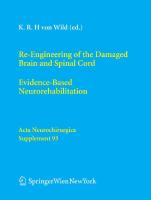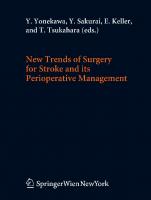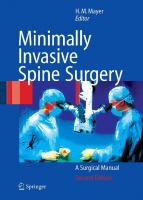Fibroid Uterus: Surgical Challenges in Minimal Access Surgery 9780367247324, 9780429284113
This book on fibroid uterus focuses on surgical challenges in minimal access surgery that a surgeon faces while treating
279 82 194MB
English Pages 200 Year 2020
Table of contents :
Cover
Half Title
Title Page
Copyright Page
Dedication
Table of Contents
Foreword
Preface
List of
Editors
List of
Contributors
Chapter 1: Counseling and Consent Challenges in a Woman with Fibroid Uterus
Introduction
Asymptomatic Fibroids and Not Planning Pregnancy
Observation or Intervention?
Asymptomatic Fibroids and Planning Pregnancy
Pregnancy with Fibroids
Women with Submucosal Fibroids
Fibroids in Perimenopausal Age and Beyond
Consent Before Myomectomy
Consent Before Hysterectomy for Fibroid Uterus
Laparoscopy/Laparotomy
Risk of Sarcoma or Malignancy During Myomectomy/Hysterectomy
References
Chapter 2: Preoperative Ultrasound Imaging in Fibroid Uterus
Introduction
Settings on the Machine
Typical Features of Fibroids ON ULTRASOUND
Classification of Fibroids
Ultrasound Modalities to Map the Fibroids
2D Transvaginal and Transabdominal Ultrasound
3D Ultrasonography
Role of MRI in Fibroid Mapping
Other Methods of Mapping Fibroids
Elastography
Sonohysterography
Steps for Fibroid Mapping
Vaginal Entry
Evaluating the Uterus
Location of Each Fibroid in the Uterus
Position of the Fibroid
How to Measure Fibroids on Ultrasound Scan
Echogenicity
Relationship of the Fibroid to the Endometrium
Endomyometrial Junction
Vascularity of the Fibroids
Reporting in a Case of Fibroid Uterus
Conclusion
References
Chapter 3: MRI before Myomectomy: How Can It Help You?
Magnetic Resonance Imaging (MRI) Scanners and Hardware
MRI Pulse Sequences
Sequences in MRI
Planes of Imaging
Descriptive Terminology
Appearance of Various Tissues in Different Sequences
Diffusion-Weighted Imaging
MRI Technique
Patient Preparation
MRI Protocol
Planning for Axial and Coronal Sections for the Body and Cervix of the Uterus
Normal Uterine Anatomy on MRI
CBA
MRI for Fibroids
International Federation of Gynecology and Obstetrics Classification of Myomas
Advantages of Using MRI
Differentiating Fibroid from Adenomyosis
Direct Signs of Adenomyosis on MRI
Indirect Signs of Adenomyosis on MRI
Diagnosing Leiomyosarcoma or Possible Sarcomatous Transformation of a Fibroid
Differentiate a Subserosal Fibroid from an Ovarian Tumor
References
Chapter 4: Fibroid and Infertility: When to Suggest Myomectomy?
Introduction
Etiopathogenesis
Clinical Presentation
Impact of Fibroids on Fertility
Mechanisms of Infertility in Fibroids
Physical Factors
Effect on Uterine Peristalsis
Molecular Impact
Genetic Alterations
Impact of Fibroids on Reproductive Outcome
Submucosal Fibroids
Intramural Fibroids
Subserosal Fibroids
Management of Women with Fibroids and Infertility
Fibroid Evaluation
Pelvic Examination
Imaging of Fibroids
Conclusion
References
Chapter 5: Surgical Treatment of Fibroids
Introduction
Microscopic Facts and Fibroid Viability
Costs of Fibroids
Reasons for Hysterectomies in Patients with Fibroids
Review of All Uterine-Preserving Treatment Possibilities for Fibroids
Expectant Management
Medical Therapy
Alternative Treatment Methods
Uterine-Preserving Surgical Treatment of Fibroids
Counseling and Informed Consent
Myomectomy
Hysteroscopic Myomectomy
Laparoscopic Myomectomy
Abdominal Myomectomy
Robotic Myomectomy
Hysterectomy as Treatment for Myomas
Should Ovaries or Fallopian Tubes (or Both) Be Removed or Left in Place at Hysterectomy?
Ovaries
Fallopian Tubes
Conclusion
References
Chapter 6: Reducing Intraoperative Blood Loss in Myomectomy: Better to Prepare and Prevent than Repair and Repent
Introduction
Classification System
Approaches to Reduce Blood Loss
Preoperative Approaches
Gonadotropin-Releasing Hormone Analogues
Ulipristal Acetate
Intraoperative APPROACHES
Misoprostol
Oxytocin
Vasopressin
Bupivacaine and Epinephrine
Antifibrinolytics
Gelatin–Thrombin Matrix
Intraoperative Uterine Artery Occlusion
Hysteroscopic Myomectomy
Laparoscopic Myomectomy
References
Chapter 7: Hysteroscopic Myomectomy: Resection Techniques and Safety
Surgical Techniques for Hysteroscopic Myomectomy
Resectoscopy
Morcellation or Tissue Removal System
Enucleation
Hysteroscopic Myolysis
Myoma G0 (Sessile or Pedunculated)
Myoma G1 or G2
Resectoscopy with Monopolar Energy
Resectoscopy with Bipolar Energy
“Cold Loop”
Vaporization
Morcellator or TRS
Laser
References
Chapter 8: Laparoscopic-Assisted Myomectomy
Introduction
When to Choose a Patient for Laparoscopic-Assisted Myomectomy
Laparoscopic-Assisted Myomectomy
Our Technique
Discussion
Advantages of this Approach
References
Chapter 9: Robot-Assisted Myomectomy
Introduction
Robot-Assisted Laparoscopic Myomectomy
Key Surgical Steps
Morcellation/Tissue Extraction
Conclusion
References
Chapter 10: Robotic Myomectomy: Tips and Tricks
Patient and Trocar Positioning
Surgical Technique
References
Chapter 11: Cervical Fibroids: Techniques for Myomectomy and Hysterectomy
Introduction
Diagnosis
Preoperative Preparations
Surgical Approach
Surgical Technique
Removal of Myoma
Defect Closure
Prevention of Adhesion Formation
Hysterectomy
Anticipated Complications and Management
Excessive Blood Loss
Role of Vasopressin in Myomectomy
Laparoscopic Uterine Artery Ligation
Temporarily Blocking Methods
Ureteric Injury
Postoperative
Points to Remember
References
Chapter 12: Broad Ligament Fibroids: Techniques for Myomectomy and Hysterectomy
Introduction
Diagnosis
Preoperative Preparations
Surgical Approach
Surgical Technique
Backyard Theory
Removal of Fibroids
Anticipated Complications
Concealed Hematoma Formation
Ureteric Injury
Role of Vasopressin in Myomectomy
Postoperative
Points to Remember
References
Chapter 13: Breach of the Endometrial Cavity during Myomectomy and Its Implications for Subsequent Fertility
Introduction
Uterine Fibroid and Infertility
Submucous Myoma
Intramural Myoma
Nonspecific Myoma
Indications for Preconception Myomectomy
How to Avoid A BREACH IN Endometrial Cavity?
How to Repair an Endometrial Cavity
The Complication of Breach of Endometrial Cavity during Myomectomy
Intrauterine Adhesion and Infertility
Conclusion
References
Chapter 14: Predictors of Uterine Rupture and Recurrence after Myomectomy
Introduction
Uterine Rupture
Obstetrical Aspects
Surgical Aspects
Recurrence
Commonly Proposed Potential Risk Factors
Other Factors to Be Considered
Conclusion
References
Chapter 15: Secondary Hemorrhage after Myomectomy
Secondary Hemorrhage Following Myomectomy
Management of Secondary Hemorrhage
Conclusion
References
Chapter 16: Laparoscopic Surgery for Fibroid Uterus: When to Convert to Laparotomy
Introduction
So How Do We Define Conversion from Laparoscopic Approach to Laparotomy?
Why Worry about Conversion and When Is that Decision Made?
Reasons for Conversion
Conclusion
References
Chapter 17: Cesarean Section in the Setting of Fibroid Uterus and Cesarean Myomectomy
Introduction
Epidemiology and Symptoms of Fibroids
Treatment of Fibroids
Myomectomy during Cesarean Section: A Historical Overview
Cesarean Myomectomy
Techniques of Cesarean Section with Myomectomy
Risks of Cesarean Myomectomy
Surgical Technique of Intracapsular Myomectomy during Cesarean Section
Conclusion
References
Chapter 18: Adenomyomectomy
Indications
Investigations
Two-Dimensional Ultrasonography
Magnetic Resonance Imaging
Surgical Treatment for Adenomyosis
Partial Reduction Surgeries
Wedge Resection of the Uterine Wall
Transverse H-Incision of the Uterine Wall
Complete Adenomyosis Excision
Triple-Flap Method
Asymmetric Dissection Method
Laparoscopic Approach to Adenomyosis
Postoperative Pregnancy Outcomes
Uterine Rupture Risk
Factors Causing Uterine Ruptures
Contraception Period BEFORE PLANNING Pregnancy AFTER ADENOMYOMECTOMY
Laparotomy versus Laparoscopic Surgery
Challenges Faced with Adenomyomectomy and Modifications
Diagnosis
Extent of Removal
Technical Difficulties
Associated Complications
Preoperative Gonadotropin-Releasing Hormone Agonists
Vasopressin
Defect Closure
Laparoscopic Uterine Artery Occlusion or Ligation
Timing of Surgery
Adhesions
Combined Surgical Medical Treatment
Robotic Adenomyomectomy
Follow-up
Conclusion
References
Chapter 19: Morcellation Techniques for Fibroid Uterus
Introduction
Era of Morcellators
Variations and Areas of Concern in Morcellation of Fibroids
The Phase Beyond the Morcellation Controversy
Total Health-Care Technique of Contained Visual in-Bag Morcellation of Fibroids - Uterus
Surgical Steps of Contained Bag Morcellation
Results
Discussion
Conclusion
References
Chapter 20: Parasitic Fibroids
Introduction
Pathogenesis
Location
Treatment
Conclusion
References
Chapter 21: Laparoscopic Hysterectomy in the Setting of Large Fibroids
Prerequisites for a Smooth Surgery
Patient Position
Port Placement
Methods to Reduce Intraoperative Blood Loss
Preoperative Methods
Perioperative Methods
Intraoperative
Uterine Manipulation
Vaginal Uterine Manipulator
Myoma Screw as Manipulator
Specimen Retrieval
Vaginal Morcellation
Bisection
Myomectomy
Laparoscopic Morcellation
Minilaparotomy
Points to Remember
References
Chapter 22: Robotic Hysterectomy in Fibroid Uterus
Indications for Surgical Therapy of Uterine Fibroids
Treatment of Fibroid in Women Contemplating Pregnancy [15]
Surgical Procedure Robotic Hysterectomy
Complications
Complication Rates in Robotic versus Laparoscopic Approach [20]
Robotic VERSUS Laparoscopic Approach
Conclusion
References
Index
Cover
Half Title
Title Page
Copyright Page
Dedication
Table of Contents
Foreword
Preface
List of
Editors
List of
Contributors
Chapter 1: Counseling and Consent Challenges in a Woman with Fibroid Uterus
Introduction
Asymptomatic Fibroids and Not Planning Pregnancy
Observation or Intervention?
Asymptomatic Fibroids and Planning Pregnancy
Pregnancy with Fibroids
Women with Submucosal Fibroids
Fibroids in Perimenopausal Age and Beyond
Consent Before Myomectomy
Consent Before Hysterectomy for Fibroid Uterus
Laparoscopy/Laparotomy
Risk of Sarcoma or Malignancy During Myomectomy/Hysterectomy
References
Chapter 2: Preoperative Ultrasound Imaging in Fibroid Uterus
Introduction
Settings on the Machine
Typical Features of Fibroids ON ULTRASOUND
Classification of Fibroids
Ultrasound Modalities to Map the Fibroids
2D Transvaginal and Transabdominal Ultrasound
3D Ultrasonography
Role of MRI in Fibroid Mapping
Other Methods of Mapping Fibroids
Elastography
Sonohysterography
Steps for Fibroid Mapping
Vaginal Entry
Evaluating the Uterus
Location of Each Fibroid in the Uterus
Position of the Fibroid
How to Measure Fibroids on Ultrasound Scan
Echogenicity
Relationship of the Fibroid to the Endometrium
Endomyometrial Junction
Vascularity of the Fibroids
Reporting in a Case of Fibroid Uterus
Conclusion
References
Chapter 3: MRI before Myomectomy: How Can It Help You?
Magnetic Resonance Imaging (MRI) Scanners and Hardware
MRI Pulse Sequences
Sequences in MRI
Planes of Imaging
Descriptive Terminology
Appearance of Various Tissues in Different Sequences
Diffusion-Weighted Imaging
MRI Technique
Patient Preparation
MRI Protocol
Planning for Axial and Coronal Sections for the Body and Cervix of the Uterus
Normal Uterine Anatomy on MRI
CBA
MRI for Fibroids
International Federation of Gynecology and Obstetrics Classification of Myomas
Advantages of Using MRI
Differentiating Fibroid from Adenomyosis
Direct Signs of Adenomyosis on MRI
Indirect Signs of Adenomyosis on MRI
Diagnosing Leiomyosarcoma or Possible Sarcomatous Transformation of a Fibroid
Differentiate a Subserosal Fibroid from an Ovarian Tumor
References
Chapter 4: Fibroid and Infertility: When to Suggest Myomectomy?
Introduction
Etiopathogenesis
Clinical Presentation
Impact of Fibroids on Fertility
Mechanisms of Infertility in Fibroids
Physical Factors
Effect on Uterine Peristalsis
Molecular Impact
Genetic Alterations
Impact of Fibroids on Reproductive Outcome
Submucosal Fibroids
Intramural Fibroids
Subserosal Fibroids
Management of Women with Fibroids and Infertility
Fibroid Evaluation
Pelvic Examination
Imaging of Fibroids
Conclusion
References
Chapter 5: Surgical Treatment of Fibroids
Introduction
Microscopic Facts and Fibroid Viability
Costs of Fibroids
Reasons for Hysterectomies in Patients with Fibroids
Review of All Uterine-Preserving Treatment Possibilities for Fibroids
Expectant Management
Medical Therapy
Alternative Treatment Methods
Uterine-Preserving Surgical Treatment of Fibroids
Counseling and Informed Consent
Myomectomy
Hysteroscopic Myomectomy
Laparoscopic Myomectomy
Abdominal Myomectomy
Robotic Myomectomy
Hysterectomy as Treatment for Myomas
Should Ovaries or Fallopian Tubes (or Both) Be Removed or Left in Place at Hysterectomy?
Ovaries
Fallopian Tubes
Conclusion
References
Chapter 6: Reducing Intraoperative Blood Loss in Myomectomy: Better to Prepare and Prevent than Repair and Repent
Introduction
Classification System
Approaches to Reduce Blood Loss
Preoperative Approaches
Gonadotropin-Releasing Hormone Analogues
Ulipristal Acetate
Intraoperative APPROACHES
Misoprostol
Oxytocin
Vasopressin
Bupivacaine and Epinephrine
Antifibrinolytics
Gelatin–Thrombin Matrix
Intraoperative Uterine Artery Occlusion
Hysteroscopic Myomectomy
Laparoscopic Myomectomy
References
Chapter 7: Hysteroscopic Myomectomy: Resection Techniques and Safety
Surgical Techniques for Hysteroscopic Myomectomy
Resectoscopy
Morcellation or Tissue Removal System
Enucleation
Hysteroscopic Myolysis
Myoma G0 (Sessile or Pedunculated)
Myoma G1 or G2
Resectoscopy with Monopolar Energy
Resectoscopy with Bipolar Energy
“Cold Loop”
Vaporization
Morcellator or TRS
Laser
References
Chapter 8: Laparoscopic-Assisted Myomectomy
Introduction
When to Choose a Patient for Laparoscopic-Assisted Myomectomy
Laparoscopic-Assisted Myomectomy
Our Technique
Discussion
Advantages of this Approach
References
Chapter 9: Robot-Assisted Myomectomy
Introduction
Robot-Assisted Laparoscopic Myomectomy
Key Surgical Steps
Morcellation/Tissue Extraction
Conclusion
References
Chapter 10: Robotic Myomectomy: Tips and Tricks
Patient and Trocar Positioning
Surgical Technique
References
Chapter 11: Cervical Fibroids: Techniques for Myomectomy and Hysterectomy
Introduction
Diagnosis
Preoperative Preparations
Surgical Approach
Surgical Technique
Removal of Myoma
Defect Closure
Prevention of Adhesion Formation
Hysterectomy
Anticipated Complications and Management
Excessive Blood Loss
Role of Vasopressin in Myomectomy
Laparoscopic Uterine Artery Ligation
Temporarily Blocking Methods
Ureteric Injury
Postoperative
Points to Remember
References
Chapter 12: Broad Ligament Fibroids: Techniques for Myomectomy and Hysterectomy
Introduction
Diagnosis
Preoperative Preparations
Surgical Approach
Surgical Technique
Backyard Theory
Removal of Fibroids
Anticipated Complications
Concealed Hematoma Formation
Ureteric Injury
Role of Vasopressin in Myomectomy
Postoperative
Points to Remember
References
Chapter 13: Breach of the Endometrial Cavity during Myomectomy and Its Implications for Subsequent Fertility
Introduction
Uterine Fibroid and Infertility
Submucous Myoma
Intramural Myoma
Nonspecific Myoma
Indications for Preconception Myomectomy
How to Avoid A BREACH IN Endometrial Cavity?
How to Repair an Endometrial Cavity
The Complication of Breach of Endometrial Cavity during Myomectomy
Intrauterine Adhesion and Infertility
Conclusion
References
Chapter 14: Predictors of Uterine Rupture and Recurrence after Myomectomy
Introduction
Uterine Rupture
Obstetrical Aspects
Surgical Aspects
Recurrence
Commonly Proposed Potential Risk Factors
Other Factors to Be Considered
Conclusion
References
Chapter 15: Secondary Hemorrhage after Myomectomy
Secondary Hemorrhage Following Myomectomy
Management of Secondary Hemorrhage
Conclusion
References
Chapter 16: Laparoscopic Surgery for Fibroid Uterus: When to Convert to Laparotomy
Introduction
So How Do We Define Conversion from Laparoscopic Approach to Laparotomy?
Why Worry about Conversion and When Is that Decision Made?
Reasons for Conversion
Conclusion
References
Chapter 17: Cesarean Section in the Setting of Fibroid Uterus and Cesarean Myomectomy
Introduction
Epidemiology and Symptoms of Fibroids
Treatment of Fibroids
Myomectomy during Cesarean Section: A Historical Overview
Cesarean Myomectomy
Techniques of Cesarean Section with Myomectomy
Risks of Cesarean Myomectomy
Surgical Technique of Intracapsular Myomectomy during Cesarean Section
Conclusion
References
Chapter 18: Adenomyomectomy
Indications
Investigations
Two-Dimensional Ultrasonography
Magnetic Resonance Imaging
Surgical Treatment for Adenomyosis
Partial Reduction Surgeries
Wedge Resection of the Uterine Wall
Transverse H-Incision of the Uterine Wall
Complete Adenomyosis Excision
Triple-Flap Method
Asymmetric Dissection Method
Laparoscopic Approach to Adenomyosis
Postoperative Pregnancy Outcomes
Uterine Rupture Risk
Factors Causing Uterine Ruptures
Contraception Period BEFORE PLANNING Pregnancy AFTER ADENOMYOMECTOMY
Laparotomy versus Laparoscopic Surgery
Challenges Faced with Adenomyomectomy and Modifications
Diagnosis
Extent of Removal
Technical Difficulties
Associated Complications
Preoperative Gonadotropin-Releasing Hormone Agonists
Vasopressin
Defect Closure
Laparoscopic Uterine Artery Occlusion or Ligation
Timing of Surgery
Adhesions
Combined Surgical Medical Treatment
Robotic Adenomyomectomy
Follow-up
Conclusion
References
Chapter 19: Morcellation Techniques for Fibroid Uterus
Introduction
Era of Morcellators
Variations and Areas of Concern in Morcellation of Fibroids
The Phase Beyond the Morcellation Controversy
Total Health-Care Technique of Contained Visual in-Bag Morcellation of Fibroids - Uterus
Surgical Steps of Contained Bag Morcellation
Results
Discussion
Conclusion
References
Chapter 20: Parasitic Fibroids
Introduction
Pathogenesis
Location
Treatment
Conclusion
References
Chapter 21: Laparoscopic Hysterectomy in the Setting of Large Fibroids
Prerequisites for a Smooth Surgery
Patient Position
Port Placement
Methods to Reduce Intraoperative Blood Loss
Preoperative Methods
Perioperative Methods
Intraoperative
Uterine Manipulation
Vaginal Uterine Manipulator
Myoma Screw as Manipulator
Specimen Retrieval
Vaginal Morcellation
Bisection
Myomectomy
Laparoscopic Morcellation
Minilaparotomy
Points to Remember
References
Chapter 22: Robotic Hysterectomy in Fibroid Uterus
Indications for Surgical Therapy of Uterine Fibroids
Treatment of Fibroid in Women Contemplating Pregnancy [15]
Surgical Procedure Robotic Hysterectomy
Complications
Complication Rates in Robotic versus Laparoscopic Approach [20]
Robotic VERSUS Laparoscopic Approach
Conclusion
References
Index

- Author / Uploaded
- Rooma Sinha
- Arnold Advincula
- Kurian Joseph
- Similar Topics
- Medicine
- Surgery, Orthopedics





![Master Techniques in Orthopaedic Surgery Relevant Surgical Exposures 2nd Edition [2 ed.]
9780781798914, 0781798914, 2007037789](https://ebin.pub/img/200x200/master-techniques-in-orthopaedic-surgery-relevant-surgical-exposures-2nd-edition-2nbsped-9780781798914-0781798914-2007037789.jpg)
![Surgical Rationales in Functional Reconstructive Surgery of the Upper Extremity [1st ed. 2023]
3031320042, 9783031320040](https://ebin.pub/img/200x200/surgical-rationales-in-functional-reconstructive-surgery-of-the-upper-extremity-1st-ed-2023-3031320042-9783031320040-b-5308131.jpg)
![Surgical Talk - Lecture Notes in Undergraduate Surgery [3 ed.]
9781848166141](https://ebin.pub/img/200x200/surgical-talk-lecture-notes-in-undergraduate-surgery-3nbsped-9781848166141.jpg)
![Surgical Rationales in Functional Reconstructive Surgery of the Upper Extremity [1st ed. 2023]
3031320042, 9783031320040](https://ebin.pub/img/200x200/surgical-rationales-in-functional-reconstructive-surgery-of-the-upper-extremity-1st-ed-2023-3031320042-9783031320040.jpg)
![Robotic Surgery Devices in Surgical Specialties [1st ed. 2023]
3031351010, 9783031351013](https://ebin.pub/img/200x200/robotic-surgery-devices-in-surgical-specialties-1st-ed-2023-3031351010-9783031351013-c-6704549.jpg)